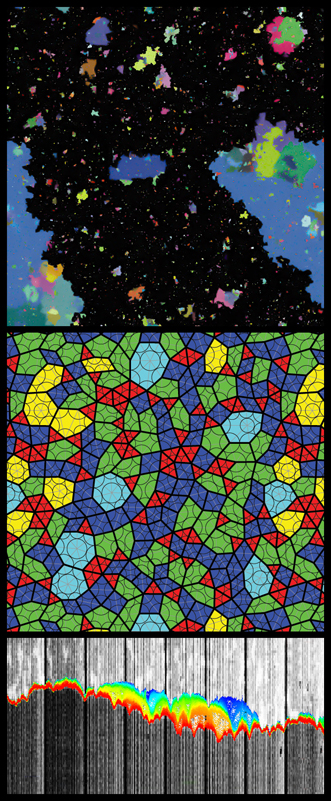Karin Dahmen
Unifying theory of universal quake statistics: from nanocrystals to earthquakes
 Many systems respond to small forcings with large fluctuations, often with sudden snaps/cracks or crackles that can span many orders of magnitude in size. Examples range from the crackling noise emitted when milk invades rice crispies to sudden rearrangements in densely packed granular materials to events such as earthquakes, landslides, and snow avalanches. Similar sudden responses are seen in other contexts, including magnetization avalanches in magnetic materials, resistivity fluctuations in superconductors, and blackouts of power grids. A better predictive and physical understanding of these kinds of sudden responses would be quite useful in a wide range of applications.
Many systems respond to small forcings with large fluctuations, often with sudden snaps/cracks or crackles that can span many orders of magnitude in size. Examples range from the crackling noise emitted when milk invades rice crispies to sudden rearrangements in densely packed granular materials to events such as earthquakes, landslides, and snow avalanches. Similar sudden responses are seen in other contexts, including magnetization avalanches in magnetic materials, resistivity fluctuations in superconductors, and blackouts of power grids. A better predictive and physical understanding of these kinds of sudden responses would be quite useful in a wide range of applications.
Recently Professor Dahmen’s research group has contributed simple models that offer this promise, showing, for example, that their simple model for the jerky deformation characteristics of materials describes the statistical properties of fluctuations in slowly compressed crystalline pillars. The model allows many predictions that can be tested.
During her Center appointment Professor Dahmen will co-organize and participate in an extended interdisciplinary research workshop at the Kavli Institute of Theoretical Physics, University of California–Santa Barbara. The workshop presents a unique opportunity for Professor Dahmen to collaborate with experts on a broad range of different systems and expand her group’s model and test its predictions using experiments, simulations, and observations. The workshop will also explore potential applications of the results to materials testing and hazard prevention.
